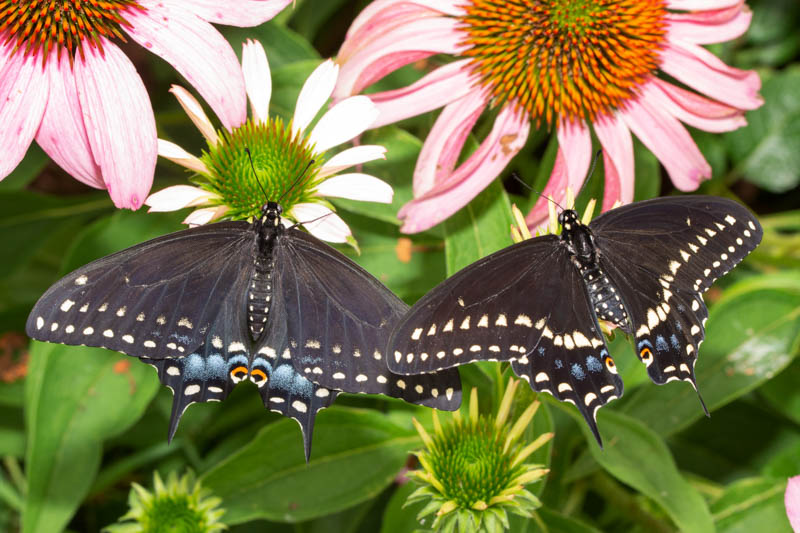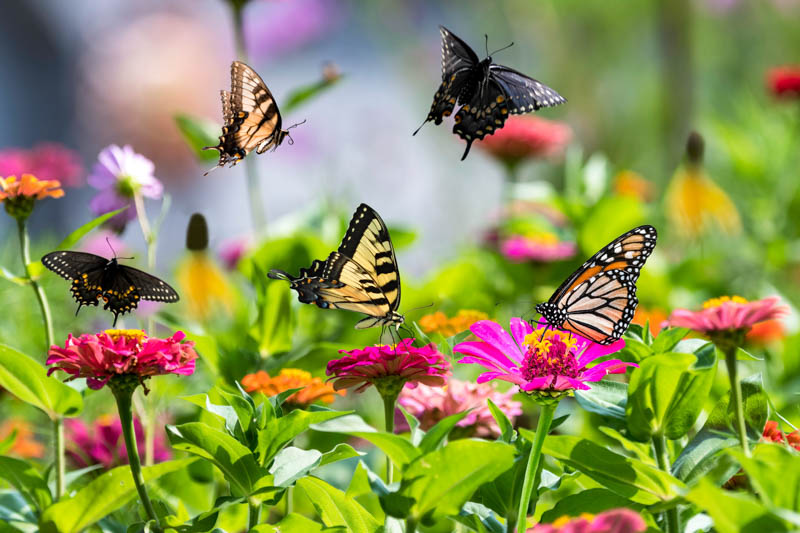American Swallowtail, Parsnip Swallowtail, Papilio polyxenes
The Black Swallowtail butterfly, scientifically known as Papilio polyxenes, is a prominent species in North America. Several names commonly refer to it:
The Black Swallowtail is a versatile species that thrives in a wide range of environments across North America. Its geographical range extends from southern Canada through the continental United States to northern Mexico. This butterfly favors open, sunny areas with abundant flora and is commonly found in meadows, fields, gardens, marshes, and even urban settings like parks and backyard gardens. It is especially prevalent in the Eastern states but also occupies parts of the Great Plains and the West under suitable conditions.
In its northern range, the Black Swallowtail typically produces one to two generations per year. However, in the warmer southern states, it may produce multiple generations, leading to a continuous presence from spring through fall.
It has been designated as the state butterfly of Oklahoma.
The Black Swallowtail is a medium to large butterfly with a wingspan of about 3 to 4 inches (7-10 cm). Sexual dimorphism is evident, as males and females exhibit different color patterns.
Male Black Swallowtail:
Female Black Swallowtail:
Both sexes have the characteristic tails on their hindwings, which resemble those of swallows, hence the name “swallowtail.” The dimorphism in color and pattern serves as camouflage for females and as a territorial display for males.
|
|
|
Courtship in Black Swallowtails typically occurs in the afternoon and can be quite an aerial spectacle. It begins with the male’s search for receptive females. Males will patrol and scan for potential mates in areas where females are likely to be found, such as near host plants.
When a male spots a potential mate, he engages in a behavior known as “fluttering,” where he flies in quick, rapid motions around the female to gain her attention. This fluttering can also serve to disperse pheromones that may make the male more attractive to the female.
If the female is receptive, she may allow the male to land and mate with her. However, if she is not interested, she may fly away or assume a refusal posture, where she raises her abdomen to prevent mating.
 Two Black Swallowtail butterflies perched on Purple Coneflowers, a female on the left and a male on the right
Two Black Swallowtail butterflies perched on Purple Coneflowers, a female on the left and a male on the right
Upon a successful courtship display, the actual mating takes place. The pair will join at their abdomens and may remain coupled for an hour or more as the male transfers a spermatophore to the female. This not only contains sperm for fertilization but also provides the female with a nutritional boost, which is important for the development of her eggs.
After mating, females will spend their remaining days searching for suitable host plants on which to lay their fertilized eggs. They prefer plants from the carrot family, such as parsley, dill, carrot tops, and fennel. Females will carefully choose locations that provide enough food for the caterpillars upon hatching.
Males, on the other hand, may continue to search for additional mates. Black Swallowtail butterflies do not mate for life and will engage with multiple partners throughout their lifespan.
The Black Swallowtail’s life cycle is a captivating display of metamorphosis, consisting of four primary stages: egg, larva (caterpillar), pupa (chrysalis), and adult (butterfly).
Egg Stage: The life cycle begins when a female lays small, spherical eggs on the host plant. The preferred host plants are typically members of the Apiaceae family, such as parsley, dill, fennel, and carrot. These eggs are pale yellow or green and hatch within a week or two.
Larval Stage: Upon emerging, the larvae feed voraciously on the host plant leaves. As the larvae grow, they molt several times, shedding their skin and revealing larger, more developed bodies. The caterpillars are known for their defensive osmeterium, a bright yellow-orange organ that can emit a foul smell to deter predators.
|
|
|
Pupal Stage: After the final molting stage, the caterpillar forms a chrysalis. The chrysalis can vary in color, often blending with the surroundings for camouflage. It may be green or brown, depending on the environment. In this stage, which can last from ten days to two weeks, or even overwinter in colder climates, the remarkable transformation into an adult butterfly takes place.
Adult Stage: The fully developed butterfly emerges with damp, folded wings. It must rest and allow its wings to dry and harden before taking its first flight. The life span of an adult Black Swallowtail can range from two weeks to about a month during which mating and the laying of new eggs ensure the continuation of the species.
The diet of the Black Swallowtail butterfly varies depending on its life stage:
Caterpillar (Larva): Black Swallowtail caterpillars primarily eat the leaves of plants in the Apiaceae family, which includes a wide range of aromatic plants with compound umbels, such as:
The caterpillars are often found in herb gardens due to their preference for these cultivated herbs.
Adult Butterfly: The adult Black Swallowtail butterflies feed on the nectar of a variety of flowering plants. They are especially attracted to blooms that are rich in nectar and have flat-topped or clustered flowers, such as:
They have long, straw-like proboscises that allow them to reach into deep flowers to access nectar. In their pursuit of nectar, they play a role in plant pollination.
Flight: The Black Swallowtail butterfly is known for its relatively strong and swift flight patterns. These butterflies are quite agile in the air and can perform quick, darting movements when disturbed or when evading predators.
Overwintering: Unlike the famous monarch butterflies, Black Swallowtails do not engage in long-distance migration. In the colder parts of their range, Black Swallowtail butterflies overwinter in the chrysalis stage (pupae), and the adults emerge in spring to repopulate areas. In milder climates, they can have several generations per year and do not need to overwinter as strictly.
Black Swallowtail butterflies, like many other butterfly species, have a variety of predators at different stages of their life cycle. Here are some of the common predators they face:
Birds: Many bird species are known to feed on butterflies, although Black Swallowtails may be less palatable due to the toxins they sequester from their host plants.
Spiders: Spiders can capture butterflies in their webs or ambush them when they come to rest or feed.
Wasps: Several species of wasps will prey on caterpillars, including those of the Black Swallowtail. Some wasps are also parasitoids, laying eggs inside the caterpillars.
Mantises: Praying mantises are adept at catching various insects, including butterflies, with their powerful forelegs.
Ants: Ants can attack and consume butterfly eggs, caterpillars, and sometimes even chrysalises.
Rodents: Small rodents like mice may prey on chrysalises attached to plant stems or buildings.
Amphibians: Frogs and toads can catch adult butterflies with their sticky tongues.
Insect Larvae: Other insect larvae, such as those of certain beetles, may eat butterfly eggs or small caterpillars.
Parasitic Flies: Tachinid flies and other parasitic flies lay their eggs on or inside caterpillars. The hatching larvae consume the host from the inside out.
Black Swallowtail butterflies have evolved several strategies to defend themselves against these predators. Their eggs are small and hidden, caterpillars can absorb toxins from their host plants which make them unpalatable, and the adults are agile fliers. Furthermore, their larval stage possesses an osmeterium, an organ emitting foul smell to deter predators.

Attracting Black Swallowtail butterflies involves creating an environment that provides for their needs throughout their lifecycle – from caterpillar to adult. Here’s how you can make your garden inviting for them:
Plant Host Plants for Caterpillars: Include plants from the Apiaceae family, such as dill, parsley, fennel, and Queen Anne’s lace, as well as plants from the Rutaceae family, like common rue. These are the preferred food sources for Black Swallowtail caterpillars.
Grow Nectar Plants: Adult Black Swallowtails feed on a variety of flowers. Plant nectar-rich flowers like zinnias, milkweed, Joe-Pye weed, butterfly bush (Buddleja spp.), phlox, and ironweed. Include a range of species that bloom at different times to provide nectar throughout the season.
Provide Sun and Shelter: Butterflies generally need sunny open areas to bask and raise their body temperature, but they also need shelter from strong winds. Include some flat stones in sunny spots for them to warm up on, and plant some shrubs or trees for windbreaks and roosting spots.
Avoid Pesticides: Pesticides can kill caterpillars and adult butterflies. Use organic methods of pest control and tolerate a little bit of plant damage from the caterpillars you’re trying to attract.
Offer Water Sources: Butterflies need water but can’t drink from open water. Instead, they sip from moist soil and sand. Provide a shallow dish with damp sand or mud, sometimes called a butterfly “puddling” area, for them to drink from and absorb minerals.
Leave Some Wild Spaces: Having areas of your garden that are a little wild can provide additional resources for caterpillars and butterflies, such as additional host plants and hiding spots.
Garden Layout: Consider the layout of your garden. Planting in groups rather than singly can help butterflies conserve energy as they collect nectar.
Use Butterfly Houses: While not all butterfly species will use them, having a butterfly house provides a potential shelter for the insects during inclement weather.
By providing for their basic needs and considering their lifecycle, you can enjoy the beauty of Black Swallowtail butterflies in your garden while contributing to the preservation of the species.
Create a membership account to save your garden designs and to view them on any device.
Becoming a contributing member of Gardenia is easy and can be done in just a few minutes. If you provide us with your name, email address and the payment of a modest $25 annual membership fee, you will become a full member, enabling you to design and save up to 25 of your garden design ideas.
Join now and start creating your dream garden!
Create a membership account to save your garden designs and to view them on any device.
Becoming a contributing member of Gardenia is easy and can be done in just a few minutes. If you provide us with your name, email address and the payment of a modest $25 annual membership fee, you will become a full member, enabling you to design and save up to 25 of your garden design ideas.
Join now and start creating your dream garden!